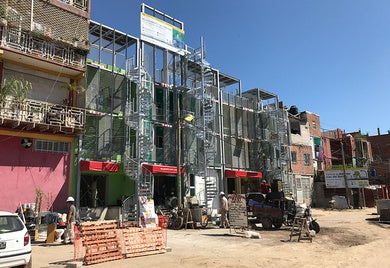Posts by Financial Institutions

Unleashing certainty: The catalytic effects of the Panama Canal expansion
Over two years ago citizens of the United Kingdom voted to leave the European Union, a decision which has been playing out on the global stage ever since . While the Brexit referendum unleashed a wave of uncertainty that seems to be growing as negotiations continue, other public votes such as the referendum to expand the Panama Canal, have had the opposite effect.

How can character count toward identifying good credit clients?
The financing gap for micro, small and medium-sized enterprises (MSMEs) in Latin America and the Caribbean was estimated at $1.2 trillion in 2017, nearly a quarter of the global emerging market total. If this gap were a country, not only would it be a credit desert for most inhabitants, but it would edge out Mexico as number 15 on the list of the world’s largest economies in terms of nominal gross domestic product (GDP).

What is a future flow securitization and what are the benefits?
Imagine that you represent an operationally strong company in a small or island country. You have helped it grow a business line specifically linked to the export of an essential product (oil or copper, for example) or the processing of financial transfers from abroad (credit cards, remittances, etc.), and see promising projections for the future. In addition, you want to diversify your current funding sources, which come from more traditional sources like commercial banks or nonfinancial institutions. Did you know that the existing and future cash flows of your business could be used to obtain another source of financing? This is how the securitization of future flows works, a little-known alternative with multiple benefits for the companies of Latin America and the Caribbean. A future flow securitization allows an enterprise (bank or corporate) to monetize existing and predictable cash flows expected to continue over the ordinary course of your business. The flows generated by the company are used to pay the debt service to the investors on the financing. Some examples of future flows from assets that are used in capital markets include: 1) Future financial flows like payments on receipts from international credit cards (Visa, MasterCard, American Express, among others), family remittances, and payments of foreign direct investment; and 2) Future flows of companies such as payments for exports of aluminum or zinc, or dollar-denominated payments from the sale of airline tickets, and other items. Generally, future flow securitizations in foreign currency involve the creation of a special purpose vehicle (SPV) in a jurisdiction different from that of the company that is the originator of the flows. The originator, through a true sale, backed by a legal opinion from an accredited law firm, sells ownership of the future flows to the SPV. The establishment of an SPV outside the country of the originator company allows the investors to mitigate some risks such as convertibility and transfer risks. In many cases, this reduced risk materializes when an international risk rating is obtained for future flow financing that is higher than the rating for the company itself (which entails a reduction in the cost of financing). In other words, both companies and investors benefit. The following graph presents a diagram of flows in a future flow financing transaction: What are the advantages of future flow financing? Long-term financing: The terms tend to be longer than the financing from commercial banks. They can be between five and ten years. Recently, IDB Invest approved the subscription of a note to be issued by the future flows program of the Federación de Cajas de Crédito y Bancos de los Trabajadores (Fedecredito) for $15 million with a seven-year term. Diversified funds platform: Facilitates the creation of a financing platform that allows multiple issuances, provided the minimum debt coverage and flow growth requirements are met. This allows for the participation of multiple institutional investors over time. Impact on development in small and island countries: The ability to mitigate certain sovereign risks in these transactions allows investors to invest with greater security in activities that produce an impact on the development of the region. In 2013, Banco Industrial Guatemala issued a ten-year bond, in which the IDB Group acquired $150 million, to increase access to financing for micro, small, and medium-sized enterprises, with a special focus on rural areas and women-led businesses in Guatemala. Securitizations of future flows are a source of alternative funding that can help to enhance your company’s growth, improve risk management in your company, and expand the base of funding sources to include international institutional investors. If you want more information, we invite you to visit our webpage on capital markets solutions. Subscribe to receive more content like this! [mc4wp_form]

Sustainable Finance: What can the financial sector do to better manage environmental and social risks?
In January 2018, Larry Fink, the CEO of BlackRock published an open letter to the CEOs of publicly traded companies. His message was clear, companies have a responsibility to deliver profit, and make “a positive contribution to society.” Failure to do the latter comes at the risk of losing its license to operate. Consumers can influence through decisions to purchase products from companies that value broader corporate goals of environmental impact, workforce diversity, and community engagement. What may come as a surprise statement from a private equity fund with $6 trillion under management is increasingly the de facto market standard.

How we incentivize social inclusion through Sustainable Infrastructure? The case of Villa 31
Recently I visited the Villa 31 in Buenos Aires, Argentina. It is a poor and informal neighborhood located at approximately 500 meters from La Recoleta, one of the most sophisticated areas of the Argentinian capital. Despite this proximity, near 45,000 residents at Villa 31 have lived in isolation, not accepted as true “porteños” by their neighbors due to the social and economic characteristic of their community. My hope is that a new development project of sustainable infrastructure in the area changes this scenario. During my visit, I met fantastic people, but I experienced a strong mix of feelings. 20 years ago, I worked on an urban rehabilitation project in Brazil, which provided new homes, electricity, water, and sanitation to hundreds of low income people. By the end of the project, high-level dignitaries from the Government and other entities visited the new homes. One of them approached a woman benefited by the project and asked: “Are you happy? Is your life better?” She looked at him and said: “No, I am much worse off today. Before the project, I lived in a shack, I had no light, no water, no job, but no bills either. Now I have been given this nice house with bills to pay, but I still do not have a job. I do not know what to do”. 20 years after, I still carry this experience with me, even though we have learned a lot about urban development and inclusion projects ever since. The number of success stories has been growing, but its nature remains rather complex and represents a significant challenge to governments, policy makers, and financiers alike. According to an Inter-American Development Bank report: “Poverty-targeted projects that did not include specific objectives to reach excluded populations often reinforced their exclusion”. We must avoid this at all cost and work on the inclusion since the beginning. From Villa 31 to Villa “Thirty and Everyone” Working on sustainable infrastructure is not only about building new houses, but to improve the entire ecosystem around them to mobilize more human and economic resources that help people to break the poverty cycle. Villa 31 is not an isolated case. In Latin American and the Caribbean cities, informal areas can concentrate up to 50% of its habitants, and according the estimates, these number will keep rising. Development processes must include habitants’ perspective. Local communities have a voice, and the fact that we are listening to them makes a huge difference in terms of long-term acceptance, appropriation and viability. During my days at the Villa, I saw the construction taking place and the physical infrastructure being implemented. The work on water, sanitation, accessible roads, energy and electrified systems at Villa 31 is allowing its inclusion into Buenos Aires. More importantly, I saw people smiling and the pride on their eyes not only for the new structures, but for having a voice and being really included. So much that the initiative has been called Treinta y Todos (“Thirty and Everyone”) by Horacio Rodríguez Larreta, Buenos Aires city Mayor. This project has renewed people’s belief that their children would have the opportunity to live a different and better life, which is an essential success factor in such complex situation. Walking the talk at the Villa The feeling when leaving Villa 31 was completely different to what I felt 20 years ago, after our conversation with that woman in Brazil. I saw a high sense of trust and hope, so high that residents are already investing their own capital on improving their homes and establishing new business, such as: restaurants or beauty shops. Complementary initiatives like these are key, considering near 70% of the urban population of Latin America and the Caribbean works in the services sector, according UN-Habitat. A new socio-economic dynamic is developing, and some important external factors are fueling the process forward. The decision to establish a major government office building from the Education Ministry at the Villa provides a strong signal. However, it is not the only one. At the Inter-American Development Bank Group (IDB Group) we firmly believe in ‘walking the talk’, and the construction of the new Argentinian representation in Villa 31 shows it. This is a bold sign of commitment to the country and, more importantly, to the people. As part of the IDB Group, IDB Invest (formerly known as Inter-American Investment Corporation) is mobilizing resources and creating financial tools to stimulate private investments on these projects. Other public and private institutions should learn about the changes at the Villa, and hopefully decide to stand up and support this process too. [gallery type="slideshow" link="file" size="full" ids="7752,7753,7755,7757,7758,7759"] Subscribe to receive more content like this! [mc4wp_form]

How to attract more private capital to PPPs
As an engine of economic growth and poverty reduction, PPPs are on the rise in Latin America and the Caribbean (LAC). In the last decade, there were approximately 1,000 PPP infrastructure projects valued at $360 billion. Especially, in our current market of constrained fiscal budgets and deep social inequalities, PPPs have become more relevant than ever. Despite this historic uptick, many projects cannot mobilize sufficient private capital. PPPs crowd-in approximately one dollar of commercial finance for every dollar of public finance – a 1:1 ratio which has failed to close the infrastructure funding gap. On the supply side, institutional investors hold funds equivalent to 20 percent of the region’s GDP - a compelling figure when we seek an additional 2-2.5 percent of GDP to meet demand. Managing long-term assets like pensions and insurance is an ideal match for the long-term tenors of PPP projects. In addition, PPPs offer investors relatively predictable repayment schedules, promising financial returns and protection from inflation. In the past, private capital, namely from institutional investors, has been cautious. However the ability to mitigate certain risks is making projects more bankable and piquing investor interest. 1. Legal and regulatory risks Legal and regulatory risks span policies, regulations and institutions. Strengthening them to address market failures, incentivize risk-sharing and regulate consistently reassures investors. Countries are setting up government agencies and units with expertise to supervise PPPs. Advisory services to governments can further strengthen institutions, their regulators and supervisory mechanisms as well as long-term project programming. 2. Project preparation risk Capacity-building combined with the right incentives can mitigate project preparation risk. This can optimize project efficiency, predictability and investor-friendliness. Technical assistance can support project investment plans and share knowledge with public officials at PPP promotion agencies. Supporting investment planning can align PPP development with nationally- determined contributions. This fosters more climate-resilient, sustainable projects. Advisory also allows governments to determine optimal delivery models by conducting value for money assessments to ensure each asset brings value to government agencies, investors and end-users. 3. Foreign exchange risk Most PPPs, except for many in the energy sector, where they are often dollar-denominated, rely on local currency. For a PPP to succeed, avoiding foreign exchange risk is key. Governments are limited in the amount of dollars they can guarantee. Mobilizing local currency allows local borrowers to repay in the currency they are generating cash flow, avoiding mismatches. Currency risk can be mitigated by investors setting up local treasuries to issue debt in local currencies or by providing local currency guarantees project-by-project. 4. Construction risk Construction risk includes expropriation, geological and additional exposures to loss during the construction phase. Investors prefer to invest in PPPs only once construction is complete. However, de-risking projects through liquidity facilities, blended finance, subordinated debt and completion guarantees, which cover construction risk and up to the first 24 months of operation, can bring further comfort and incentivize early entry. Multilateral development banks are uniquely positioned to offer many of the solutions that address legal, regulatory and project preparation risks. IDB Invest (formerly known as Inter-American Investment Corporation), on behalf of the IDB Group, recently mitigated risks and attracted institutional investors in the Reventazón hydropower project in Costa Rica and Campo Palomas and Colonia Arias wind farms in Uruguay. The next phase seeks to bring institutional investors to PPPs and at construction phase. Besides, we can lend in local currency, as we are currently doing in Paraguay, Brazil, Colombia and Mexico, and we can also deploy guarantee and debt instruments to mitigate construction risk. Our in-house experts analyze infrastructure pipelines, support country planning and deploy financial and non-financial products that enhance infrastructure project risk profiles. IDB Invest, on behalf of the IDB Group, recently mitigated risks and attracted institutional investors in the Reventazón hydropower project in Costa Rica and Campo Palomas and Colonia Arias wind farms in Uruguay. The next phase seeks to bring institutional investors to PPPs and at construction phase. As the region’s PPP pipelines continue to grow, we will deploy the solutions to maximize PPP bankability and mobilize more financing. The boost we see in PPPs brings benefits for governments, private firms and the citizens of the countries we serve. [gallery type="slideshow" link="none" size="full" ids="7775,7776,7777"] Subscribe to receive more content like this! [mc4wp_form]
